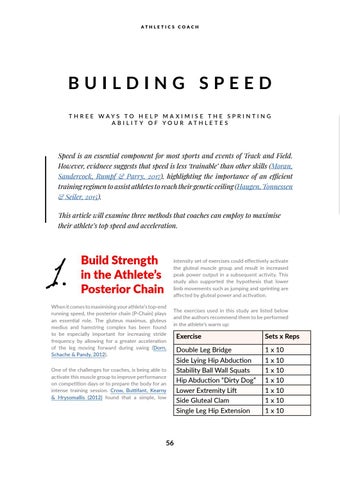ATHLETIC S COACH
BUILDING SPEED THREE WAYS TO HELP MA XIMISE THE SPRINTING A B I LIT Y O F YO U R ATH LE TE S
Speed is an essential component for most sports and events of Track and Field. However, evidnece suggests that speed is less ‘trainable’ than other skills (Moran, Sandercock, Rumpf & Parry, 2017), highlighting the importance of an efficient training regimen to assist athletes to reach their genetic ceiling (Haugen, Tonnessen & Seiler, 2015). This article will examine three methods that coaches can employ to maximise their athlete’s top speed and acceleration.
1.
Build Strength in the Athlete’s Posterior Chain
intensity set of exercises could effectively activate the gluteal muscle group and result in increased peak power output in a subsequent activity. This study also supported the hypothesis that lower limb movements such as jumping and sprinting are affected by gluteal power and activation.
When it comes to maximising your athlete’s top-end running speed, the posterior chain (P-Chain) plays an essential role. The gluteus maximus, gluteus medius and hamstring complex has been found to be especially important for increasing stride frequency by allowing for a greater acceleration of the leg moving forward during swing (Dorn, Schache & Pandy, 2012).
The exercises used in this study are listed below and the authors recommend them to be performed in the athlete’s warm up:
One of the challenges for coaches, is being able to activate this muscle group to improve performance on competition days or to prepare the body for an intense training session. Crow, Buttifant, Kearny & Hrysomallis (2012) found that a simple, low
56
Exercise
Sets x Reps
Double Leg Bridge
1 x 10
Side Lying Hip Abduction Stability Ball Wall Squats Hip Abduction “Dirty Dog” Lower Extremity Lift Side Gluteal Clam Single Leg Hip Extension
1 x 10 1 x 10 1 x 10 1 x 10 1 x 10 1 x 10














